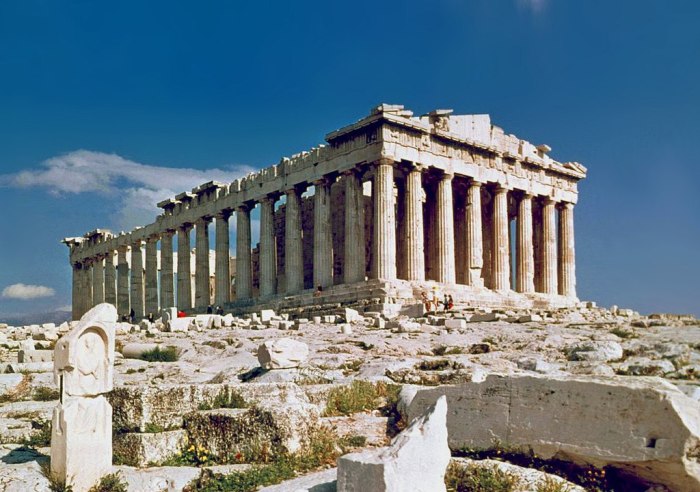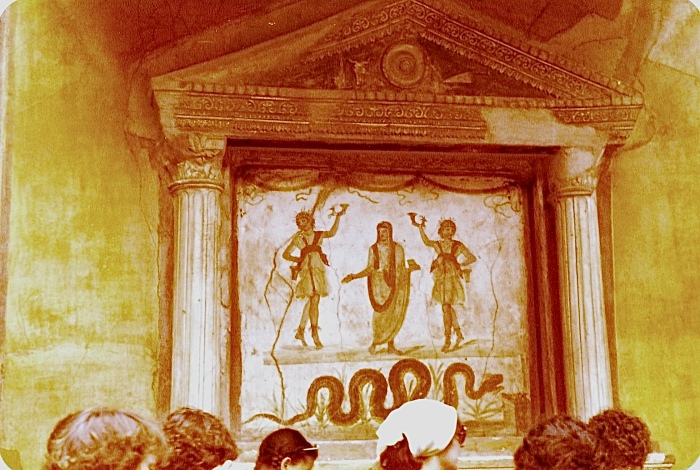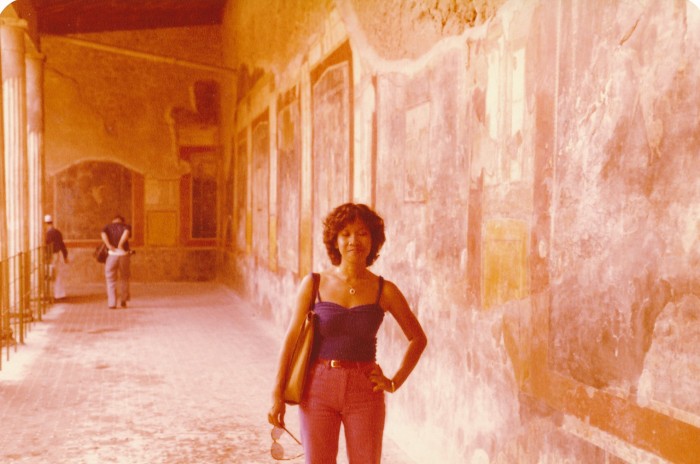Part 2: Impressions of my first visit decades ago
I’ve since returned a few times, concentrating on certain places.
Athens, Greek Islands
September 3
I’m not exactly prepared for what I see in the airport. It’s small and understaffed. A lot of tourists visit Athens but it seems the city won’t coddle them.
More surprises await us in our hotel room. The bathroom sink is huge, about 18” by 24”, but the shower at 18” by 18” won’t accommodate a large person. Sonia is flabbergasted. All we could do is make the most of the situation and tell ourselves this is all part of the adventure of being in a foreign land.
September 4
Today, after downtown Athens, we visit the Acropolis that the local guide Maria, a fascinating well-informed Greek lady full of warmth, brings back to life for us. I’m awed by the glory that lived here so many centuries before the British empire. The Acropolis is a well-thought-out piece of engineering and architectural wonder made to stand, it seems, for infinity. The Parthenon in particular had been built as a monument as well as a center of culture to be enjoyed by all Greeks.

Parthenon (https://commons.wikimedia.org/wiki/File:The_Parthenon_in_Athens.jpg#/media/File:The_Parthenon_in_Athens.jpg )
Greek food is good. The lamb is young, tender, and mouth-watering. After unexciting English food at exorbitant British prices, dining in Greece is a treat.
It’s hard to know what the Greeks think of the American tourist. He is tolerated, to be sure, but not courted.
September 5
We go on a Greek island cruise for a whole day. I don’t know what to expect.
The cruise is boring or relaxing depending on one’s frame of mind. We get off at different islands but, for me, there’s a sameness from one island to the next and I would have been satisfied going on to Hydra, the last island on the itinerary.
Hydra is the typical Greek town I see in pictures with narrow alleyways separating houses. Everywhere in Greece, houses are constructed of tile, stone, and concrete. Wood is expensive.
September 6
Our next stop is Corinth and the ruins of a marketplace that was the setting for social and political gatherings among the Greeks and later, the Romans. Ladies were not allowed in this venue and there were no facilities of any kind provided for them.
It’s mind-boggling to realize how much life and activity these ruins have witnessed—public events including political debates. Where have all the Greeks gone? They seem oblivious of their glorious past. Is it because they’re now so far removed from their golden age? I notice a certain stoicism and maybe some indolence among the natives. How much have natural disasters (earthquakes, for instance, are common) affected the Greeks?
From Corinth, we drive to a hotel where Sonia and I get a room overlooking a beach and the Ionian Sea. We wade into the cleanest, clearest ocean I’ve ever encountered. It’s delightful and relaxing to feel fresh saltwater surround you.
We have our first dinner included in our tour tonight—Greek and scrumptious. That night, after a marvelous day of Greek ruins and a once-in-a-lifetime dip in the Ionian Sea, we sleep in fatigued contentment.
September 7

Hermes of Olympia (http://odysseus.culture.gr/h/4/eh431.jsp?obj_id=8898&mm_id=3002)
Our tour guide is the mayor of Olympia. He’s not Maria but, by now, my imagination has been sufficiently primed to fill in gaps.
The statue of Hermes (Mercury), sculpted in marble by Praxiteles in 700 BC, is the biggest delight of the morning. Its perfection, preserved for more than 2000 years, is a tribute to the genius of man. I stand in front of Hermes for a while, relishing the sight of this marvelous sculpture.
This afternoon, we wait impatiently for the overnight steamer that takes us to Brindisi, Italy.
Italy—On to Rome: Only in Italy—Incredulity and delight
September 8
We spend the day aboard the steamer and arrive in Italy at half past five in the afternoon.
While buying a cheap light lunch at the steamer snack bar, I strike up a conversation with a bearded American. He’s an electronics engineer who builds microcomputers for electronic toys. He claims to be shy but turns out to be fascinating. We talk for five hours! We part not knowing each other’s names.
Our entry into our first Italian town is accompanied by fanfare. Although Bari is a fairly big city, the American tourist bus attracts attention, elicits the Italian brand of chivalry, and provides an excellent pretext for showing off to the foreigner.
In the heart of downtown, two policemen on motorcycles offer to escort the bus to our hotel. We get no sirens but they stop cars to let us pass. On turning a narrow street, a small car parked on a corner obstructs our passage. The two policemen with the help of a few bystanders lift the car out of the way. Screaming and laughter issue from the incredulous Americans. With the obstruction gone, the policemen ride away and a self-appointed Italian astride a moped masterfully leads the way, forcing drivers of double-parked little cars to move on. As soon as we reach the hotel, he drives on without looking back and I hope he has enjoyed a moment of glory.
September 9
We go to Capri via Naples. After eighteen hours on the Greek steamer, the prospect of another boat ride sounds boring. But this boat is a hydrofoil that cruises through our third ocean, the Tyrrhenian Sea.
We make three transfers to get to the Blue Grotto and each succeeding one seems worse—from the bus to a hydrofoil, to a medium-sized motorboat to a little rowboat. My sense of adventure doesn’t sustain me through getting rocked and splashed with water on a slippery motorboat. It’s a bit scary but jumping on to a swaying, precariously tilted rowboat is all I need to lose my enthusiasm for the Grotto.
The Grotto trip turns out to be a lot of fun despite the fact that the shrine I expected in the Grotto is not there and has never been there. The scintillating cerulean sea is beautiful and our guide, singing Sorrento on top of his full, pleasant voice makes me forget our water adventure and helps me enjoy the experience.
We spend the night in Sorrento—a romantic city It’s a green city with narrow zigzag streets that somehow add charm and lyricism to a place. The next day, our drive from here to Pompeii, our next destination, is rich with breathtaking scenery.
September 10
Five minutes into Pompeii, we get our first downpour. It signals the coming of fall to Italy. No one is prepared for this. We left our raincoats in our suitcases, and they will be inaccessible for the next eight hours.
After an hour, the rain stops and we’re off to the Pompeii ruins. This is much larger and more impressive than our previous ruins. It’s a whole city.
Once more, my imagination takes flight, not only about public speeches and athletic competitions, but about a whole way of life. I have always thought that across centuries, civilization has progressed. Now, I’m no longer so sure.
Centuries before Christ, a civilization had flourished with a technology that appears sound to the modern man: foundations and certain sections of buildings had withstood a devastating earthquake. One palatial residence built in 2 AD is fairly intact with paintings on walls, tables, pots, and fountains. Two thousand years from now, what would be left to show of our own modern civilization?
The rest of the day is sunny and warm. Next stop: Rome.
September 11
Rome. From the moment our bus enter the walls through the Piazza Popolo, I watch in open-mouthed awe. When it comes to lasting historical monuments, classical art and other cultural artifacts, Rome tops Athens. And yet, though Athens has been ravaged more by man and nature, I can’t help paying a certain reverend homage to it. It produced great minds, like Plato and Aristotle, whose ideas continue to influence us today.
We visit the Vatican and all we could possibly peruse of its basilica, museums, library, and Michelangelo’s Sistine chapel. As a work of art and a paean to man’s genius, the Vatican is unique. As a place of worship, I have some reservations. Is all this grandeur necessary to inspire a weak, fickle humanity to worship?
The Pope is a monarchical ruler presiding over spiritual lives in the grandest, possibly richest (from all that art) residence imaginable. Inside it, inaccessible to people but visible through some of the museum windows is a beautiful well-kept garden that must have been someone’s concept of paradise.
September 12
We’re on our own today. Though we need to rest, we try to do more sightseeing—the Trevi fountain, the Spanish Steps and the Pincio hill where we hope to end the day at the Borghese Gallery. But we’re tired. Our bodies have become too heavy to lug around and our groaning feet carry us to the bus stop instead of the museum. We’re proud about successfully deciphering the bus system and discovering pizzerias that sell slices for 300 lire instead of 3000 at stores around hotels and tourist areas.
For now, we’ve reached our limits. We long for the efficiency and convenience of a private car. Tonight, we also reluctantly pay 3000 lire for a slice of lasagna at a nearby deli.
Florence
September 13
Florence is magical. How I imagined it doesn’t come close to what it turns out to be. How can it when first glimpses include its central piazza (Piazza della Signoria) displaying classical works of art. And, then, you discover museums around the city center that hold priceless works of art. This is one time I wish I had read a little more about the history of a place. But maybe, in having come ignorant, seeing it fills me with greater wonder.
It’s sad that we’re here only for several hours. (How I saw Florence in later visits.) We must pick and choose what to see and rush through so many treasures. But it helps that we’re being shown old Florence by an incomparable guide—a lawyer by profession with the imposing name of Donatello (maybe after one of Italy’s great sculptors). But he wants us to call him Don. A proud Florentine, he’s educated and opinionated about art. And subtly mocking of his audience. But it’s easy to overlook his attitude. He’s quite approachable, fascinating, intelligently conversant about art, and fluent in three languages. When he spontaneously breaks out into a song and makes remarks in self-mockery, his audience is fully hooked.
The home of numerous great classical works of art like Michelangelo’s David at the Accademia and Botticelli’s Birth of Venus at the Uffizi, a day doesn’t do Florence justice. I resolve to return and stay for at least two weeks.
September 14
Rome and Florence are enough to make any country memorable but Italy remarkably also has Venice, a marvelous city we’re treated to for only a few short hours. 
Immersed in water and tourism, Venice is crowned by St. Mark’s square, a piazza of unparalleled magnitude and magnificence. St. Mark’s Cathedral sits in the square like an incongruous mosque transported out of Arabian Nights via a magic carpet.
The square is packed with people, none of whom are Venetians, says our tour guide. Except for the vendors and pickpockets who are all doing brisk business this Sunday.
Lucerne
September 15
We spend half of today on the road to Lucerne, exchanging a country of stunning cultural heritage for one with stunning hills, valleys, and lakes.
Nature has been kind to the Swiss. The country is clean and orderly, and poverty seems to be nonexistent. Its cities are small and manageable. Do the Swiss know chaos and pollution?
After the graceful and sometimes ornate architectural lines of Italy, Switzerland is a brief welcome change. Everything appears straight and geometric—from houses and lawns to meadows regularly interrupted by tall, triangular spruce trees.
September 16
There are a lot of towers in Lucerne. And all those towers have clocks. All the tower clocks give correct time.
Swiss precision is not confined to time devices. Today, I find out it has been extended to cogwheel trains and cable cars as we ride up and down Mount Pilatus.
I’m a little apprehensive watching trains go 8000 feet up a steep mountain while we’re waiting for our turn. But a few minutes in the train, moving at a stable and constant pace, convince me that the Swiss have also mastered the art of climbing mountains.
Mt Pilatus lives up to our expectations of picturesque, breathtaking sights. We ogle idyllic, pastoral scenes that I’ve only seen in picture books and movies. Coming up here has been more fun than all the Disneyland rides I’ve been on. Much healthier as well, as we treat our lungs to fresh clean mountain air.
A Bit of Paris
September 17
This day is lost in thirteen hours of travel from Lucerne to Paris. I’m bored and tired as we approach Paris.
The tour director starts talking about the magic of Paris as we drive into the outskirts of the city. I feel some excitement slowly awakening in me and in the lethargic bus. But tonight we have only enough energy to go searching for dinner.
September 18
Paris is an enormous city in population and area spread across twenty arrondissements. A lot of construction is going on in the outer sections where modern skyscrapers already stand.
The Paris of history and culture that people have seen in movies and articles is concentrated in the city center (centreville). There, it’s easy to see what has attracted millions of people to Paris. It seems like Rome, London, and New York rolled into one, offering something for everyone.
But I’m aware we’re only grazing the surface in the day and a half we’re here. How, for instance, can you appreciate the art on offer at the vast Musée du Louvre if the itinerary devotes two hours to it? We don’t even get to go to the top of the Eiffel Tower.
Like Florence, I resolve to return and stay longer.
Tomorrow, we fly back home.







